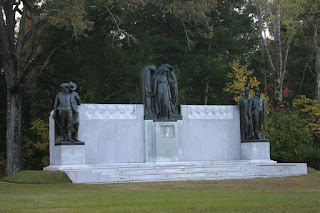As I mentioned before, because I had neglected to turn my clock back to central time, I arrived at the battlefield an hour or more before anyone else, including the park rangers. I didn't let that stop me; I just drove through the park trying to follow the prescribed route so I wouldn't miss anything.
The main object of the exercise was photography. I've read enough about Shiloh to have a good handle on what went on. I just wanted to see the park with few people around and take advantage of the early morning light.
The symbolism of the cannons distributed about the park seems at odds with the peace and serenity of the park today, nearly 150 years after the battle.
The log cabin above is Shiloh Church, which gave its name to the battle. Much of the battle took place in the immediate vicinity. The structure was destroyed shortly after the war ended and this cabin was erected on the original site in about 1875. There is a new church nearby begun in 1929; it was completed and dedicated in 1952.
Wandering around as I was, without a map, I apparently missed the road that would've taken me to the bluffs overlooking the Tennessee River. I knew the river was over there on the other side of these trees, but I never found my way over there. But I enjoyed sharing my morning in the park with the many deer and turkeys.
The cannon shots at these battlefield parks always remind me of my favorite television production ever - Ken Burns' Civil War mini-series. And that, of course, was based on my favorite history book ever - Shelby Foote's Civil War Narrative.
I like the monuments which incorporate statuary best, but some of the lesser monuments are equally impressive in their stonework. The wide distribution of the monuments scattered across the large well-manicured acreage of some of the parks emphasizes the immensity of the struggle and honors the participants on both sides.



















































